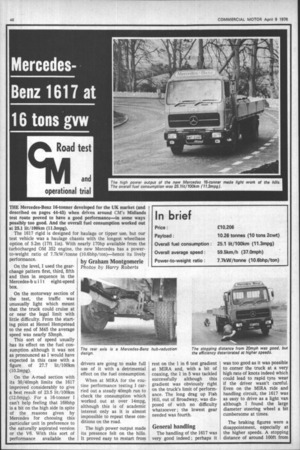Mercedes
Page 48

If you've noticed an error in this article please click here to report it so we can fix it.
Benz 1617 at 16 tons gvw
Road test
THE Mercedes-Benz 16-tanner developed for the UK market (and described on pages 44-45) when driven around CM's Midlands test route proved to have a good performance—in some ways possibly too good. And the overall fuel consumption worked out at 25.1 lit/100km (11.3mpg).
The 1617 rigid is designed for haulage or tipper use, but our test vehicle was a haulage chassis with the longest wheelbase option of 5.2m (17ft lin). With nearly 170hp available from the turbocharged OM 352 engine, the new Mercedes has a powerto-weight ratio of 7.7kW/tonne (10.6bhp/ton)—hence its lively performance. by Graham Montgomerie On the level, I used the gearchange pattern first, third, fifth and then in sequence in the Mercedes-b ui It eight-speed box.
On the motorway section of the test, the traffic was unusually light which meant that the truck could cruise at or near the legal limit with little difficulty. From the starting point at Hemel Hempstead to the end of M45 the average speed was nearly 53mph.
This sort of speed usually has its effect on the fuel consumption although it was not as pronounced as I would have expected in this case with a figure of 27.7 lit/100km (10.2mpg).
On the A-road section with its 30/40mph limits the 1617 improved considerably to give a best result of 23,5 lit/100km (12.0mpg). For a 16-tonner I can't help feeling that 168bhp is a bit on the high side in spite of the reasons given by Mercedes for choosing this particular unit in preference to the naturally aspirated version or the V6. With this sort of performance available the drivers are going to make full use of it with a detrimental effect on the fuel consumption.
When at MIRA for the routine performance testing I carried out a steady 40mph run to check the consumption which worked out at over 14mpg, although this is of academic interest only as it is almost impossible to repeat these conditions on the road.
The high power output made its presence felt on the hills. It proved easy to restart from rest on the 1 in 6 test gradient at MIRA and, with a bit of coaxing, the 1 in 5 was tackled successfully although this gradient was obviously right on the truck's limit of performance. The long drag up Fish Hill, out of Broadway, was disposed of with no difficulty whatsoever ; the lowest gear needed was fourth.
General handling
The handling of the 1617 was very good indeed ; perhaps it was too good as it was possible to corner the truck at a very high rate of knots indeed which could lead to rapid tyre wear if the driver wasn't careful. Even on the MIRA ride and handling circuit, the 1617 was as easy to drive as a light van although I found the large diameter steering wheel a bit cumbersome at times.
The braking figures were a disappointment, especially at the higher speeds. A stopping distance of around 100ft from




























































































































